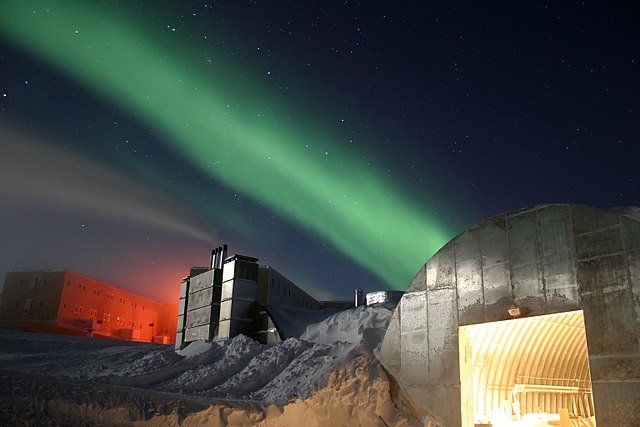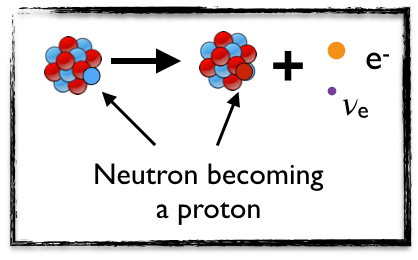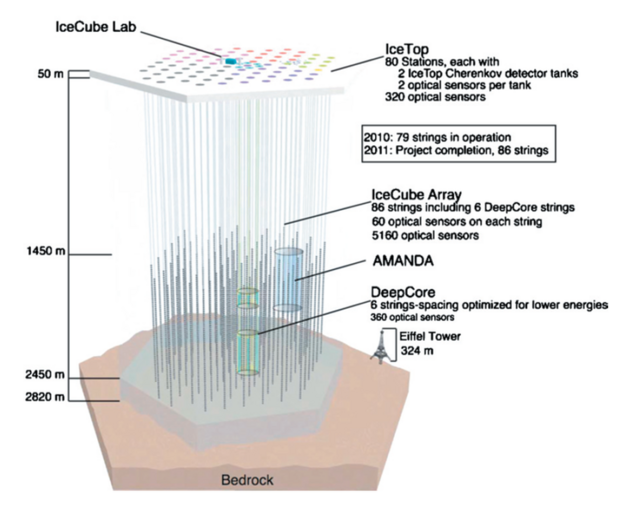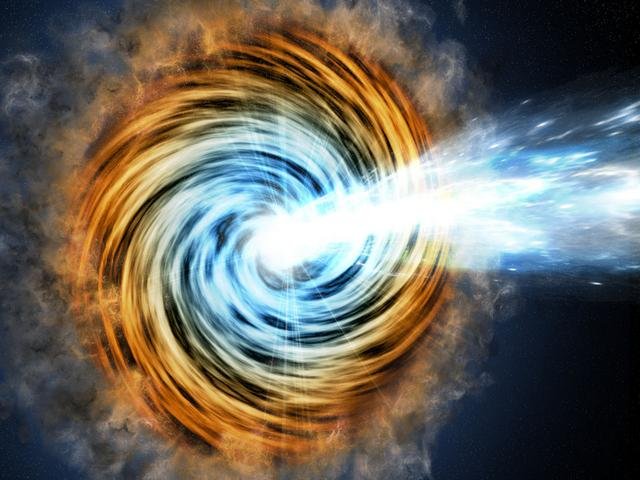A breakthrough in astrophysics - observation of a first powerful engine to accelerate cosmic rays
Last Thursday, the IceCube collaboration announced the discovery of a cosmic source of both highly-energetic neutrinos and gamma rays. It consists in a first of a kind, which is why this news is so exciting for the particle physics and astrophysics communities.

[image credits: Chris Danals (public domain)]
In my recent posts, I discussed two interesting features of neutrino data from the OPERA and MiniBooNe experiments, connected to the fact that the three known species of neutrinos oscillate into each other when they propagate.
Today, we will significantly deviate from this topic and move to neutrino astrophysics: neutrino reaching Earth after a long trip in space.
I will try to make this post self-contained and define slowly all the necessary concepts. Please do not hesitate to ask any question if needed.
NEUTRINOS IN A NUTSHELL

[image credits: homemade]
The picture on the right is my favorite picture to introduce neutrinos. It shows the decay of an atom into another atom, together with the emission of an electron and a neutrino.
Neutrinos were introduced more than 100 years ago, when physicists were discovering radioactivity.
From the study of atomic decays such as the one of the picture, they concluded that the energy produced by the reaction was shared by the visible electron and an invisible guy, that was coined a neutrino a bit later.
Today, these phenomena are well understood, in particular at the fundamental level of the Standard Model of particle physics.
However, among all the three interactions embedded in the Standard Model, neutrinos are only sensitive to the weak force. As a result, they can travel long distances, following a straight line, without interacting with anything.
This is crucial for what concerns cosmic rays.
COSMIC RAYS
Whilst radioactivity was being discovered (100 years ago), cosmic rays were also discovered by Hess. He discovered that Earth was bombarded by particles coming from space, and actually got a Nobel prize for this.

[image credits: NASA (public domain)]
Those cosmic rays can be made of many different particles (including neutrinos but also all the elements of the periodic table) and have energies spanning dozens of orders of magnitude.
The mechanism behind their creation and their acceleration to such high energies is still unknown today, so that it lies at the core of the astrophysics research program.
But why focusing on neutrinos?
Most cosmic rays are made of charged particles or photons (the latter being better known as gamma rays). As a result, they will interact with anything they will encounter on their trip to Earth, and in particular with all the strong magnetic fields populating space. There is thus no way to understand where those particles are coming from (unless we could know it by another mean), as the trajectories are bended by all these interactions.
This is however not the case for neutrinos that are no electrically charged. As said above, neutrinos only interact very weakly (in contrast to photons that interact with almost everything). Neutrinos can consequently travel straight to us directly from the place at which they have been produced.
They offer hence a way to get details about potentially distant sources of cosmic rays, as arriving on Earth unaltered, carrying information about the most distant places in the universe.
THE ICECUBE OBSERVATORY
By their stealthy nature, neutrinos are difficult to detect. However, thousands of billions of them go through Earth each second. Therefore, managing to detect even a tiny fraction of all of them would be sufficient to get something to study with high precision.

[image credits: Cmdrjameson (CC BY 3.0)]
This is the idea behind IceCube.
First, we maximize the size of the detector. If something occurs rarely, but equally everywhere, just scouting a huge space increases the chance to observe something.
The IceCube detector is a detector of 1 km3. As can be seen on the picture on the right, it consists in a huge array of strings full of electronics. In total, we in fact discuss more than 5000 sensors!
Next, we need a good material to make the detector of. Antarctic ice was chosen. At IceCube, neutrinos are not directly observed but reconstructed instead from their interaction with the ice.
When a neutrino hits an atom of ice, it generates a bunch of charged secondary particles than will emit Cherenkov light. Similarly to an airplane emitting a “bang” when it accelerates beyond the speed of sound, particles emit blue light when they accelerate beyond the speed of light in a given medium (in Antarctic ice, the speed of light is only of about 230.000 km/s).
This blue Cherenkov light is then detected by the electronic sensors of the detector. From its properties, one can then reconstruct the original neutrinos and derive their features.
THE DISCOVERY - A BREAKTHROUGH IN ASTROPHYSICS
On September 22nd, 2017, IceCube recorded a very highly energetic neutrino originating from a very far distance in the universe. An alert was sent to telescopes world-wide to investigate the same area of the universe, but with gamma rays.

[image credits: M. Weiss (CfA)]
The apparent source was a blazar that carries the fancy name of TXS 0506+056 (we are so good with names :p).
A blazar consists in a giant elliptical galaxy with a rotating black hole in the middle. One important feature of such beasts is that jets of very highly-energetic particles are emitted from the poles of the blackhole.
Neutrinos being apparently emitted from there were hence recorded by IceCube. So far, nothing exciting but as said above, a neutrino alert was sent to many telescopes all around the world.
And here is the exciting news: several gamma ray observatories detected flares of gamma rays coming from the exact same location! This convergence of observations convinced the community that the blazar was the source of both the cosmic neutrinos and the gamma rays.
And by “convinced”, I mean “proved” in physical terms. The significance is of about 6.5 sigma. This means we are reaching a confidence at the 99.99999999% level.
SUMMARY AND TAKE-HOME MESSAGE
Last Thursday, the IceCube collaboration has hence announced the first observation of a cosmic engine, the TXS 0506+056 blazar, capable to produce very energetic cosmic rays. This astrophysics object is indeed capable to produce and accelerate cosmic rays to incredible energies way above what man can build (by a factor of hundreds of millions).
The evidence is supported not only by neutrino observations with the IceCube detector located in Antarctica, but also with another neutrino telescope called ANTARES. Moreover, the observation has been confirmed with gamma rays, X-rays, visible light and radio-waves through about 20 telescopes including Fermi-Lat and MAGIC.
Why is this exciting? Well, this is simple: it is the first observation ever of an object capable to produce highly energetic cosmic rays. Before last Thursday, we had only suppositions about the sources of such cosmic rays and how they could get such huge energies.
Now, we have one confirmed example of a potential source of very-energetic cosmic rays.
STEEMSTEM
SteemSTEM is a community-driven project that now runs on Steem for almost 2 years. We seek to build a community of science lovers and to make Steem a better place for Science Technology Engineering and Mathematics (STEM). In particular, we are now actively working in developing a science communication platform on Steem.
More information can be found on the @steemstem blog, in our discord server and in our last project report.
You mentioned that neutrinos travel in a straight line. However space itself is curved via relativistic effects caused by massive objects (as when gravitational lensing is observed). Doesn't that mean that neutrinos need to follow a "curved" path. Am I understanding this incorrectly?
Thanks for the precision, that is entirely correct. Neutrinos are affected by gravity, as everything. Their mass being tiny, their trajectory is actually close to the photon one.
Note that with the energy range considered here, they are barely affected by any gravitational potential and can escape very easily.
No EM interference maybe
I beg your pardon? :D
? @blockchainyouth Electro-Magnetic? Just curious to the thoughts.
I am as you here. I still do not understand what (s)he meant :)
Well, maybe just a thought, it would take a massive EMP to affect the neutrino. It might be interesting to look at the effects of a coronal mass ejection or a supernova, versus the star's gravitational pull. Perhaps that was the intent of the question.
Then the answer would be: the neutrino is totally non-sensitive to electromagnetism and therefore does not care about electromagnetic fields populating space .
Moreover, it also interacts so weakly, even gravitationally, so that it is barely affected by any gravitational field too.
the lack of mass ?
neutrinos arent wimps lol ... okay ... if i hang around here for another ten years i might get a clue hahah
Thank you so much sir.
Hi @lemouth this is very well written article, thank you! I do have one question, do you know how the direction of the neutrino's are determined? To know that the source is a distant galaxy would required arc minutes of accuracy in determining the sky coordinates.
They travel straight. From the tracks they leave in the detector, we can reconstruct the initial trajectory and then get the direction where they come from.
Oh OK, it makes sense to me now as the individual sensors are laid out in a cube matrix. It is quite clever in that they use the ice to create the detector structure :)
Antarctica ice is a perfect medium for such a detection. Ice is in general clean dark and stable. Antarctica is then the only place on Earth where ice is so abundant. It is now more than 30 years that neutrino physics live nice days in Antarctica :)
Question about Antarctic ice. Is it just an iceberg from Antarctica, or is it some specially distilled frozen water?
By the way, I found this article quite easy to understand which is usually a challenge when I'm dealing with astrophysics.
The detector is located near the Amundsen-Scott station, the US station that is right at the South pole. The detector is 2.5km high and lies from the bedrock to the ground of the icefloor. It is thus really on the continent.
I actually thought about your comment when writing it. It is not as technical as the previous one and not depending on 6 previous articles to be understandable. But I will try to write a summary of my physics@utopian-io project in a few weeks, so that anyone not used to that could understand what we do, why we do it and where we go :)
What happens when the ice melts?
Ice does not melt there. The recorded temperatures at the South pole station vary from -12 Celsius to -80 Celsium (the mean temperature is -49 Celsius). Still cold enough ;)
Wow, I think I found a (new to me) community on steem that I am going to love....
Please do so! everyone is more than welcome at @steemstem ^^
I believe it was these neutrinos coming from TXS 0506+056 that was vaguely called "Ghost Particles". Now I've gotten a better insight in this.
But I want to ask: Going with the fact that billions of these neutrinos (if not trillions) pass through us; since they are virtually everywhere; does it pose any health threat to us? I mean - are cosmic rays detrimental to health?
Thanks for sharing sir
Yes, neutrinos are often called ghost particles because they are so weakly interacting they just go through anything. And this is why it is so hard to detect them.
No health issue at all for the same reason they are so weakly interacting. The probability they will interact with our body is just extremely close to zero. And if they do (this may happen 10-15 times on a lifetime I guess; I remember vaguely the number but I didn't calculate it myself), they will just be absorbed.
Otherwise, we should just use human neutrino detectors :D
Lol, yeah you're right. There wouldn't be need for the Icecube detector if the human body can detect that.
Thanks for the kind reply sir
My pleasure :)
I read about this a few days ago in the science news. I knew one of you guys would communicate this one to the local stem community.
By the way, is there any information on the time dilation for a neutrino such as this? It traveled 3.7 billion light years, but to the neutrino was it only a few minutes of travel time?
Time dilation is huge here, as neutrino travels very close to the speed of light (they are almost massless and the dilatation is infinite in the massless case). I don't have the exact numbers however.
Hi @lemouth
This is certainly a great revelation. Please what's the implication of this observation in real life application?
@sciencetech
STEM contributor
The Cherenkov effect (predicted at the end of the 19th century and observed for the first time in the 1930s) is used in many domains: medical science, nuclear reactors, astrophysics experiments (as here), etc... Plenty of places as you can see!
Ya. Thanks. You really have good knowledge of this
I work with this kind of things. I am somehow used to that by now :)
Great article @lemouth ! Pleasing to read and rather easy to understand.
I was wondering, what kind of information can a neutrino carry if it has little to no interaction with the rest of its environment?
Energy, trajectory, etc... Astrophysicists estimate that 20% of the universe is too dense to be probed with photons (the latter will be absorbed well before reaching us).
Hi @lemouth Sir!! :)
This article is really interesting to read!! You have very nicely and clearly explained all the topics. :)
Moreover I came to knew some new things here such as:
I also learnt here few new things which you connected it to MiniBooNE experiment.
Apart from my passion about space science, my second interest is physics and I love knowing and learning new things from your article here!! :)
I really enjoyed knowing the information that:
Wishing you a very happy time ahead!! :)
Thanks for passing by and glad to read you learned from my article. Do not hesitate to ask question if any :)
Sure Sir! If I will have any questions I will surely going to ask you without any hesitation!! :)
Please do :)
:)
This was really informative and a very interesting read! you mention a weak force, what is that weak force that works on neutrino’s
and just to be sure, what creates neutrino’s, it is the fact that a neutron releases an electron and the energy that is released goes into the electron and the rest makes up the neutrino’s?
Thanks for the write up! I am setting up a platform myself to tackle the issue of understanding the crypto asset market, using steemit benchmarks.
Do you perhaps know any good mathmatician that is interested in helping out what weights to use on the specific properties I write the benchmarks on?
They appear as a result of the weak interactions driving the decay of the original atom. A neutron is converted into a proton, and the released energy is converted into an electron and a neutrino.
There are a few mathematicians on the SteemSTEM discord. Maybe should you ask directly there?